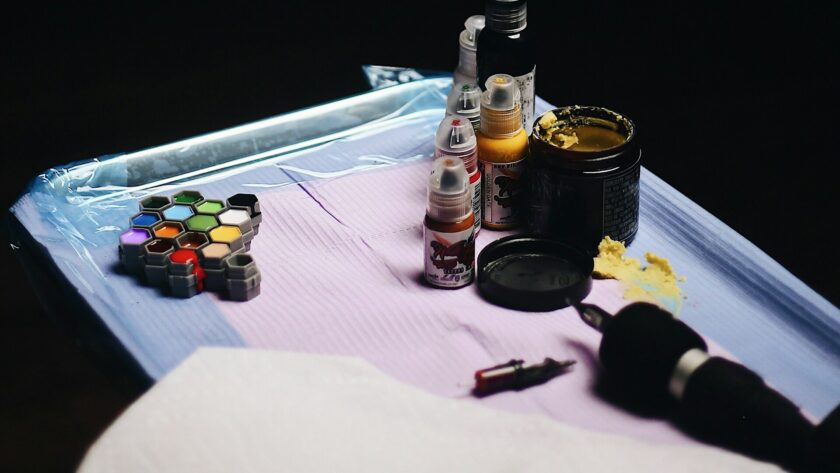Tattoo ink expiration is an essential topic for anyone who values the quality and safety of body art. Tattoo enthusiasts and artists must understand the risks and benefits tied to ink longevity. In this guide, we’ll cover everything you need to know about tattoo ink, how to recognize expired ink, and how to store it properly to avoid potential issues. Fresh ink is key to maintaining your tattoo’s vibrancy and avoiding harmful reactions.
What is Tattoo Ink Made From?
Tattoo ink consists of two major components: pigments and carriers. Pigments provide the color, and they can be organic, mineral-based, or synthetic. Common pigments include iron oxide, cadmium, and carbon. Carriers help distribute the pigment evenly across the skin and typically include substances like water, glycerin, and alcohol.
However, some inks, especially vibrant colors like red or UV/glow-in-the-dark inks, may contain toxic components. These harmful ingredients can reduce the ink’s lifespan and lead to severe allergic reactions(Using high-quality ink made from safe ingredients ensures the best results and longevity for your tattoos.
Does Tattoo Ink Go Bad?
Yes, tattoo ink does expire, and it’s crucial to recognize the signs before using it. Expired tattoo ink can lead to faded designs, infections, or allergic reactions. Indicators of expired ink include a change in consistency, separation of components, or unusual odors. Ink that smells off or has clumped should never be used, as it can cause bacterial infections and ruin the tattoo. Always check the ink’s expiration date and monitor any signs of deterioration. Using fresh ink ensures that your tattoo stays vibrant, safe, and long-lasting.
How Long Does Tattoo Ink Last?
Tattoo ink’s shelf life varies depending on the type of ink, storage conditions, and ingredients. On average, most tattoo inks last about 2 to 5 years if stored correctly. Inks with a higher content of organic pigments, such as vegan inks, may expire faster than those with synthetic components.
Properly sealed and stored ink, kept in cool, dry places away from direct sunlight, can last longer. Extreme temperatures, exposure to light, or leaving the bottle open can accelerate the ink’s expiration. Knowing how long your ink lasts and how to extend its life is key to maintaining quality tattoos.
Tip: To ensure your ink lasts longer, always shake the bottle well before each use. This helps redistribute any pigments that may have settled at the bottom, maintaining the ink’s quality and consistency.

Source – https://giphy.com/gifs/gimberdrink-shake-gimber-bottle-oclu6akESpFgzEKsbj
Health Risks of Using Expired Ink
Using expired tattoo ink can introduce a range of health risks. The most common complications include skin infections, allergic reactions, and tattoo fading. Expired ink often harbors bacteria, which can lead to painful infections that damage your skin and the design.
Additionally, old ink may cause an allergic reaction, resulting in swelling, redness, or itching. Faded tattoos are another consequence of using outdated ink. To avoid these risks, always use fresh, properly stored ink and check for signs of spoilage. Fresh ink not only ensures safety but also maintains the vibrant appearance of your tattoo.
For more details on how ink behaves during the healing process, you can read about tattoo ink sack formation and its role in ensuring your tattoo heals properly.
Expired Tattoo Ink Bacteria Types: What You Should Know
Using expired tattoo ink can pose serious health risks due to bacterial contamination. Over time, tattoo ink degrades, and bacteria may infiltrate it, especially if the ink hasn’t been stored properly. When bacteria grow in expired ink, they can cause infections once the ink is injected into the skin. Here are some common types of bacteria that can develop in expired tattoo ink:
1. Staphylococcus Aureus
One of the most common bacterial contaminants in expired tattoo ink is Staphylococcus aureus. This bacterium can cause skin infections, leading to redness, swelling, and pus-filled blisters. If untreated, it can escalate into more severe infections, like cellulitis or even blood infections (sepsis). Symptoms can appear within days after using contaminated ink and require medical attention.
2. Pseudomonas Aeruginosa
Pseudomonas aeruginosa thrives in moist environments, making improperly stored or expired tattoo ink a prime breeding ground. This bacterium can lead to severe skin infections, especially in immunocompromised individuals. Infection by Pseudomonas often results in a greenish tint on the affected skin area, accompanied by pain, itching, and discharge. This pathogen is also resistant to many antibiotics, making infections particularly dangerous.
3. Mycobacterium Chelonae
A lesser-known but highly concerning bacterium found in contaminated tattoo ink is Mycobacterium chelonae. This slow-growing bacterium can cause long-term skin infections and even lead to systemic infections if untreated. Symptoms often include bumps or nodules on the skin, which can take weeks or months to manifest, making it difficult to link the infection to expired ink. These infections may require prolonged courses of antibiotics, often lasting several months.
4. Streptococcus Pyogenes
Streptococcus pyogenes is another bacterium that can thrive in expired tattoo ink, leading to severe skin infections. Common symptoms include painful, red swelling around the tattooed area, fever, and sometimes pus-filled abscesses. This bacterium can also lead to more serious conditions like necrotizing fasciitis (flesh-eating disease) if the infection spreads deeper into the tissue. Immediate medical intervention is required to prevent complications.
Risks and Prevention
To avoid bacterial infections from expired ink, always check the ink’s expiration date and store it in a cool, dry place. Professional tattoo artists should also ensure that they are using sterile, fresh ink for each client to minimize any health risks. Regularly cleaning and disinfecting the tattoo equipment and the work environment are additional precautions to prevent contamination.
Understanding the types of bacteria that can grow in expired tattoo ink is crucial for ensuring safety. By staying vigilant, you can reduce the risk of infections and ensure the longevity and quality of your tattoos.
Proper Storage of Tattoo Ink to Extend Shelf Life
Storing tattoo ink correctly is crucial to extending its shelf life. Always keep tattoo ink in a cool, dry place, away from direct sunlight and extreme temperatures. Heat can degrade the pigments, while light can cause the ink to break down and separate. Ensure that the ink bottle is tightly sealed after each use to prevent contamination and evaporation of its carriers, like glycerin and water. Avoid using inks that have been exposed to air for too long, as they may dry out and become unusable. Following these storage tips can help preserve the ink’s quality and safety, reducing the chances of using expired ink.
How Does Tattoo Ink Get Contaminated?
Tattoo ink can become a breeding ground for bacteria through various means:
- Poor Storage Conditions: Exposure to light, heat, or air can degrade the preservatives in the ink, allowing bacteria to flourish.
- Improper Sealing: If the bottle isn’t tightly sealed, contaminants from the environment can enter, leading to bacterial growth.
- Expired Ink Components: Some ingredients in tattoo ink naturally break down over time, reducing the ink’s ability to resist bacterial contamination
Regulatory Guidelines and Safety Standards for Tattoo Ink
Regulations regarding tattoo ink safety and expiration dates vary by region, but many countries have guidelines in place to ensure that inks used in tattoos are safe. It is important to choose ink brands that comply with these regulations and always check for an expiration date before using any ink. Using regulated ink reduces the risk of infection, allergic reactions, and poor tattoo quality.
In some cases, unregulated or homemade inks can contain harmful ingredients or toxins that lead to severe complications. Always opt for reputable, regulated ink brands to ensure safety and quality.
Vegan and Organic Tattoo Inks: Are They Safer?
Vegan and organic tattoo inks have become popular alternatives to traditional ink due to their eco-friendly components and the belief that they are safer for sensitive skin. Vegan inks replace animal-derived carriers, like glycerin, with plant-based alternatives. However, these inks may still contain pigments that can expire faster or cause allergic reactions. While vegan inks are a good option for those with ethical concerns, they still need to be properly stored and checked for expiration. Using fresh vegan ink can provide a safer option for those with sensitivities, but it is not without its risks.
Conclusion
Tattoo ink expiration is a vital factor in ensuring the safety, vibrancy, and longevity of your tattoos. By understanding the components of tattoo ink, recognizing signs of expiration, and storing your ink properly, you can avoid the risks associated with using expired ink. Always choose high-quality, regulated ink and check expiration dates to protect both your tattoo and your health. Staying informed about the lifespan of tattoo ink guarantees a long-lasting and beautiful design.





